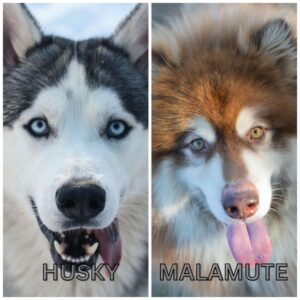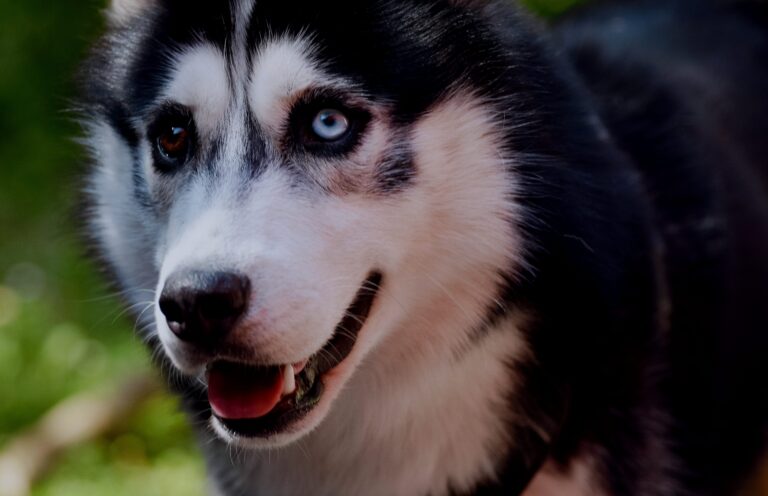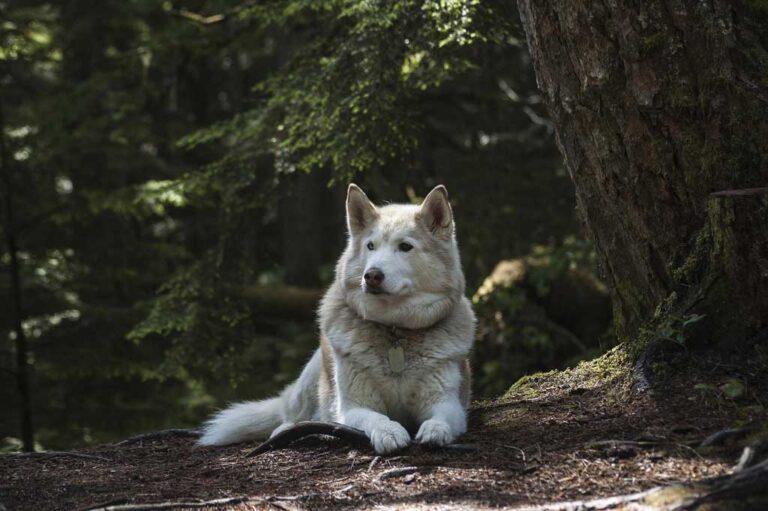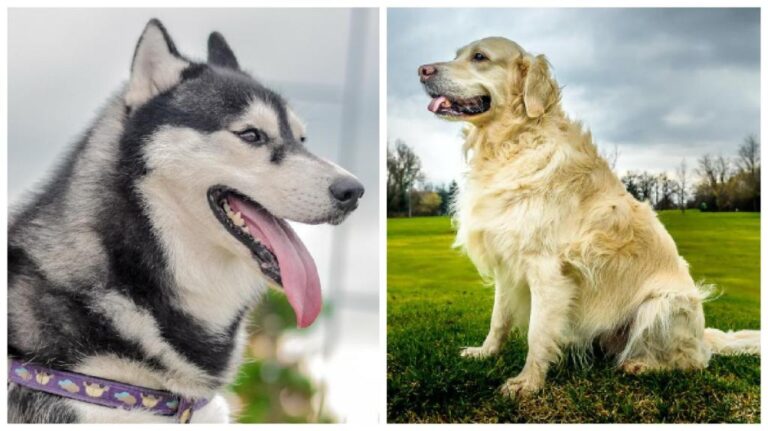Husky VS Alaskan Malamute: 9 Common Difference
We are going to talk about the fluffiest dogs: Siberian Husky vs. Alaskan Malamute. Some of the most beautiful and popular dog breeds are the Alaskan Malamute and the Siberian Husky. These dogs are suitable for cold weather and can survive in temperatures as low as minus 60 degrees Celsius. Both of these breeds look very similar, yet there are many differences between them. Let’s find out which one will be the best choice for your family.

Husky VS Alaskan Malamute Origins
Let’s learn about the origins of Husky vs. Alaskan Malamute. Both the Alaskan Malamute and the Siberian Husky were probably the oldest popular working dogs in the Northern Territory. Presumably, the Alaskan Malamute originated in Alaska in North America, and the Siberian Husky originated in Northern Asia. Both the Alaskan Malamute and the Siberian Husky are thought to have originated around 12,000 years ago.
The Alaskan Malamute was the first sled dog breed in the Arctic. They were bred to transport heavy loads over long distances at a steady pace.
Siberian Huskies are also sled dog breeds, but they also worked with sleds and were used for light and fast walking. They were very essential for transporting people and food.
In the 1900s, both the Alaskan Malamute and the Siberian Husky became popular in sled racing events.
The American Kennel Club registered the Siberian Husky in 1930 and the Alaskan Malamute in 1935.

Husky VS Alaskan Malamute Appearance
Both the Alaskan Malamute and the Siberian Husky look almost the same, but there are considerable differences between them. These differences make them easily distinguishable.
The striking feature between these two dog breeds is their wolf-like appearance. However, the Alaskan Malamute is larger than the Siberian Husky.
A male Alaskan Malamute is 25 inches (63.5 cm) tall and weighs between 85 – 100 pounds (38.5 – 45 kg).
Female Alaskan Malamutes are 23 inches (58 cm) tall and weigh between 75 – 80 pounds (34 – 35 kg).
Male Siberian huskies are 21-23.5 inches (53–60 cm) tall and weigh 45–60 pounds (20–27 kg).
Female Siberian huskies are 20–22 inches (51–56 cm) tall and weigh 35–50 pounds (16–23 kg).
Alaskan Malamutes are much stronger than Siberian Huskies because they were bred for strength. They also have thickly muscled legs, broad shoulders, and large mouths.
Alaskan malamute’s ears are low on their heads and point forward. In contrast, Siberian huskies’ ears stand straight up on their heads and make them look more alert.
The tail of the Alaskan Malamute is characterized by a bushy coat of fur, which often curls back or rises over its back. In contrast, the Siberian husky’s tail is like a furry brush.
The Alaskan Malamute only has brown eyes. Cute Siberian huskies are famous for their piercing blue eyes. Their eyes are different colors. For example, they can have brown eyes, blue eyes, or one blue and one brown eye.
Husky VS Malamute Behavior And Temperament
Both the Alaskan Malamute and the Siberian Husky have almost the same behavior and temperament. Both breeds are very cheerful, loving, playful, and calm. Both have a high prey drive.
Siberian huskies want to socialize, play, and work. They are very good with children and love to play and have fun with them.
In contrast, the Alaskan Malamute is also a working dog. They are also suitable for children. But due to the size of Malamutes, it is advised not to keep them unattended around children.
The Siberian husky is very strong. They like to be independent, and they have high-pack tendencies. But they are very soft-natured and close with everyone.
In contrast, the Alaskan Malamute is somewhat calmer. This calm nature makes them excellent companion dogs. Malamutes are often used as therapy dogs. Their soft nature, calm attitude, and love for people attract everyone.
The Siberian husky howls a lot. In contrast, Alaskan Malamutes also howl, but not as loudly as Huskies.
Both the Alaskan Malamute and the Siberian Husky are also friendly with strangers. They are not watchdogs. They never want to live in a closed environment. They always need an open environment. Where they can roam, run, and play spontaneously.
Siberian Husky VS Alaskan Malamute Coats
The Siberian Husky breed has a beautiful, thick double coat, which sheds seasonally like other double-coated dogs. Which are of different colors? Like white to grey, black or orange-brown, etc.
In contrast, the Alaskan Malamute also has a nice thick double coat, but with longer fur than the Siberian Husky. Especially on their tail, neck, and shoulders. They look very fluffy, and their fur is thicker than a Siberian husky’s coat.
The Siberian husky and Malamute both have double coats that shed seasonally twice a year. During this time, they both require daily brushing.
Siberian Husky VS Malamute Grooming
The Siberian Husky and Alaskan Malamute both shed their double coats seasonally, twice a year. During this time, they both need to be brushed several times a day.
Because the Siberian husky’s coats are short in size, you can only brush them once a week and bathe them a few times a year. There is very little dirt on their coats.
In contrast, because Alaskan Malamutes have longer coats, their coats tend to shed more than those of Siberian Huskies. So they need to be brushed several times a day. Also, their coats tend to get tangled and dirty due to their length. So they need to be bathed every six to eight weeks.
Husky VS Malamute Health Concerns
The Siberian Husky and the Alaskan Malamute are both generally healthy breeds. The average life expectancy of both is almost the same. The average lifespan of a husky can be up to 12–14 years. In contrast, the Alaskan Malamute can also live for 10 to 14 years.
Siberian Huskies are more prone to genetic disorders such as laryngeal paralysis and seizures. In contrast, Alaskan Malamutes are more prone to cancer and hip dysplasia. The incidence of hip dysplasia in Siberian huskies is very low.
Both the Siberian Husky and the Alaskan Malamute can suffer from a variety of eye problems, including cataracts, corneal dystrophy, and progressive retinal atrophy. This condition can cause vision problems or even blindness. Also,
Hypothyroidism: This is a common endocrine disorder that affects many dog breeds, including Huskies and Malamutes. It occurs when the thyroid gland does not produce enough thyroid hormone, causing weight gain, lethargy, and other symptoms.
Gastric Dilatation-Volvulus (GDV): This is a life-threatening condition that can occur when a dog’s stomach twists on itself, trapping gas and distending the stomach. It is more common in deep-chested breeds like Huskies and Malamutes and requires urgent treatment.
Allergies: Both Huskies and Malamutes can develop allergies to food or environmental allergens, causing skin irritation, itching, and other symptoms.
Cancer: Like all dogs, Huskies and Malamutes are susceptible to several types of cancer, including lymphoma, osteosarcoma, and hemangiosarcoma.
It is important to note that not all Huskies and Malamutes will develop these health problems, and many can live long, healthy lives with proper care and management. Regular veterinary checkups and preventive care can help detect and treat health problems before they become serious.
Husky VS Malamute Physical Activity And Exercise Needs
Both Huskies and Malamutes are highly active and energetic breeds that require regular exercise to stay healthy and happy. However, there are some differences in their physical activity and exercise needs.
Huskies are known for their high energy levels and require a lot of daily exercise. They are a very active breed and need plenty of physical activity to keep them mentally and physically stimulated. Huskies love to run and play, so they need plenty of opportunities to run, walk, hike, and play games like fetch. A minimum of 30–60 minutes of exercise per day is required for Huskies.
Malamutes, on the other hand, are also highly active but are known for their endurance rather than speed. They were originally bred to pull sleds and work long hours, so they required a lot of daily exercises as well. Malamutes are a bit more independent than Huskies and may be content to roam around in a fenced-in yard or go for a long walk or hike with their owners. They also enjoy activities like weight-pulling and backpacking. A minimum of 60–90 minutes of exercise per day is required for malamutes.
In summary, both Huskies and Malamutes need a lot of exercise and physical activity to stay healthy and happy, but Huskies require slightly less exercise than Malamutes. It’s important to provide them with plenty of opportunities for physical activity and mental stimulation to keep them happy and healthy.
Siberian Husky VS Alaskan Malamute Training
Both breeds can be difficult to train, but Huskies tend to be more stubborn and independent, while Alaskan Malamutes can be more responsive to training.
Husky Puppy VS Malamute Puppy: Prices
We are now going to know about Husky vs Alaskan Malamute Puppies’ price.
The price of a Husky puppy versus a Malamute puppy can vary depending on several factors, including the location, breeder, and the puppy’s age and lineage.
Generally, malamute puppies tend to be more expensive than husky puppies. This is because malamutes are a rarer breed and tend to be larger, which can require more food and resources to care for. Additionally, Malamutes are known for their working abilities, which can make them more desirable for certain tasks, such as sled pulling.
On average, a Husky puppy can cost between $600 and $1,500, while a Malamute puppy can cost between $1,500 and $3,000 or more. However, prices can vary significantly depending on the breeder, location, and the puppy’s lineage.
It’s important to keep in mind that while the price is a factor, it’s not the only one to consider when getting a new puppy. The most important thing is to find a reputable breeder who breeds healthy and well-tempered puppies and to make sure you can provide the necessary care and resources to give the puppy a happy and healthy life.
Which Breed Is Right For You?
We learned a lot about the Husky vs. Alaskan Malamute. Both Huskies and Alaskan Malamutes are beautiful and intelligent dog breeds, but they have different characteristics that might make one more suitable for you than the other.
Overall, the best dog breed for you depends on your lifestyle and preferences. If you’re an active person who enjoys spending a lot of time outdoors, a Husky might be a good fit for you. However, if you’re looking for a loyal and affectionate companion who requires less exercise, an Alaskan Malamute might be a better choice. It’s important to research both breeds and spend time with them before deciding to ensure that you choose the right dog for your lifestyle and needs.
Hi, I’m Piyas! I am a dog lover, trainer & blogger. I am passionate about pet dogs and love to learn and research how to care for, train, and learn all about them.






